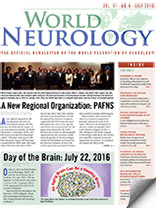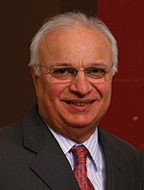
Raad Shakir, MD
The WFN is a non-governmental organization (NGO) in official relationship with the WHO. The relationship is symbiotic and solid. It started back in the 1960s during the first term of the presidency of MacDonald Critchley from 1965 to 1969. Initially, it was small and dealt with special problems related to tropical neurology. The association continued following the establishment of the mental health section during Sigvald Refsum’s presidency from 1973 to 1981. Diana Bolis was a major contributor at the time. The relationship continued when the WHO contacted the WFN regarding the revision of the neurological section of the International Classification of Diseases (ICD)-10. At the time, the WHO included stroke in the section of cardiovascular disease, in spite of WFN objections. Walter Bradley and Jean-Marc Orgogozo gave expert advice.
The relationship between the WFN and the WHO has not always been smooth and straightforward. When Richard Masland took over as president in 1981, one of his challenges was to define mental health. Later, during John Walton’s presidency from 1989 to 1997, Norman Sartorius, who was the director of the WHO Division of Mental Health, invited the leaders of the NGOs in neurosciences to an annual meeting at the end of the year. Walton, James Toole, and Andre Lowenthal met with Sartorius. The relationship continued during subsequent years. During Jun Kimura’s presidency, Johan Aarli chaired the Public Relations Committee and subsequently became first vice president and was appointed as the liaison officer between the WFN and the WHO. The relationship flourished during Aalri’s presidency from 2005 to 2009. Under the WHO leadership of Assistant Director General Ala Alwan, succeeded by Oleg Chestnov, head of section Benedetto Saraceno, and his successor Shekhar Saxena, the relationship moved full steam ahead. This was strongly cemented by the appointment of Tarun Dua, coordinator of the WHO’s Evidence, Research and Action on Mental and Brain Disorders Unit, and a pediatric neurologist who took the role as the officer responsible for neurology in the mental health section. The WFN provided several grants to joint activities, which were most rewarding. The publications of the first Neurology Atlas in 2004 and Neurological Disorders: Public Health Challenges are excellent examples.
The WHO activities in our field are crucial for the specialty. If neurology and brain health is to find its rightful place in the agenda of governments across the world, the only way is to go through the WHO. There were, over the last 40 years, several collaborative efforts and, in all, the relationship proved enduring and productive. If we look at the present time and evolving issues, neurologists are at the heart of the WHO activities.
ICD-11
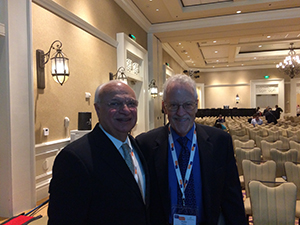
Raad Shakir (left) and Walter Bradley chair the topic advisory groups for ICD-11 and ICD-10.
There are four areas which I would like to highlight. The first is the ICD-11 project, which has now matured and is coming to publication. We have to remember that the ICD is a WHO and not a WFN process, as neurological diagnoses only form a small part of the whole ICD revision program. The ICD-11 will have short definitions for all entities, and it is crucial that the WHO secretariat, represented in our case by Dua, has the support to discuss the issues with the central classification team at the WHO. The common version to be presented in October 2016 is the Joint Linearization for Mortality and Morbidity Statistics (JLMMS) and not the neurology specialty version, which will come later. This is a crucial step to the WHO, as member states will follow this classification. It is most important to point out that, with the help of the WHO team, stroke is now part of the neurology section, which is most important for brain health future statistics. We still have some fine-tuning to do until the end of June 2016. It is inevitable that some neurology specialists, patient organizations, and others may find some of the ICD layout and content not to their liking. All of us have made efforts to reconcile the opinions and needs of neurological and neurosurgical associations and interest groups, at the same time satisfying public health needs and clinical utility, as well as other medical and surgical specialties.
I would like to use this opportunity to thank all my fellow neurologists and neurosurgeons who contributed their time and expertise over the past seven years in making the neurology ICD-11 a viable and meaningful project. The support of the WHO is vital to us in our work and continues to be so. The comments made by the central classification team were taken and acted upon. My fellow members of the Topic Advisory Group (TAG) have been wonderful in their advice and work over the years, and I had the honor to chair the neurology TAG.
WHO Non-Communicable Diseases
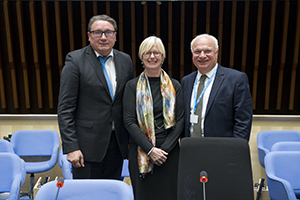
Left to right: Oleg Chestnov, WHO assistant director general; Bente Mikkelsen, GCM NCDs chair; and Raad Shakir, WFN president.
The second issue is that of the WHO non-communicable diseases (NCD) project. The NCDs launch did not initially include neurological diseases. However, since 2013, it has become clear that the neurological, mental, developmental, and substance use (NMDS) group surpasses, in numbers and in Disability Adjusted Life Years (DALYs), the cancer and cardiac disease group. Moreover, prevention is now clearly possible in many such conditions. This has led to the involvement of the WFN in the global coordinating mechanism for NCDs (GCM/NCD), headed by Dr. Bente Mikkelsen. The WFN is an official member and attended meetings for the NCD project. This is very important as the G8 London declaration on dementia states, “the G8 has an ambition to identify a cure or a disease-modifying therapy for dementia by 2025 and to increase collectively and significantly the amount of funding for dementia research to reach that goal.” The WFN has declared that there is “No health without brain health.” This has been met with approval by those involved in health provision from various parts of the world.
In the WHO structure, neurology falls under the administrative charge of the assistant director general for non-communicable diseases and mental health. The WFN has long argued to replace mental health with brain health. This, in our opinion, is more descriptive and inclusive. However, we all appreciate that there are many administrative issues and channels to convince at the WHO, as well as those involved in all aspects of brain health.
Neurology Atlas 2015
The third project nearing finalization is that of the second edition of the Neurology Atlas 2015. The first atlas was published in 2004 and was a WHO best seller. The second edition is coming this year, and we await the final publication. The countries’ resources will be detailed, and again the policies on neurological care and provisions for management will be presented. One can say, even with the preliminary data, that the provisions in low- and low, middle-income countries remain abysmal compared to high-income economies. It is also possibly true to say that the situation regarding the number of health care professionals has improved over the past 10 years. This will have to await final statistical analysis. As for WHO regions, the deficiencies remain in Africa, South Asia, Latin America, and parts of the Eastern Mediterranean region. The atlas, when published, will be of a huge benefit and impact on neurological care provision and training across the world. The WFN would like to thank the WHO secretariat, in particular Tarun Dua and her team, for all their hard work in this endeavor. The WFN is also proud to have contributed to the project financially, as well as with experts helping in the process.
World Health Assembly
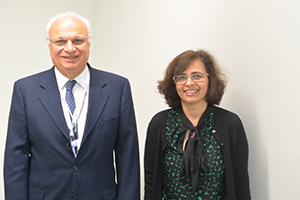
Raad Shakir (left) and Tarun Dua, coordinator of the WHO’s Evidence, Research and Action on Mental and Brain Disorders Unit.
The fourth issue is representing the interests of neurology during the World Health Assembly (WHA). The WHA is the decision-making body of the WHO. It is attended by delegations from all WHO member states and focuses on a specific health agenda prepared by the Executive Board. The WHA meets annually at the end of May. NGOs, like us, can apply to make a statement through a request, and we need to influence the secretariat well in advance to have resolutions adopted by some member states to be presented. The best example of this is the resolution on epilepsy during the 68th WHA meeting in 2015. The delegates endorsed a resolution urging member states to strengthen their ongoing efforts in providing care for people with epilepsy. Although affordable treatment for epilepsy exists, up to 90 percent of people with the condition may not be properly diagnosed or treated in resource-poor settings. The resolution highlights the need for governments to formulate, strengthen, and implement national policies and legislation to promote and protect the rights of people with epilepsy. It also stresses the need to reinforce health information and surveillance systems to get a clearer picture of the burden of disease and to measure progress in improving access to care.
Such declarations need years to achieve and the WFN congratulates the International League Against Epilepsy for its diligent work in bringing this to a conclusion. This can only help the 50 million epilepsy sufferers across the world.
For all these and many other issues, the collaboration between the WHO and the WFN will continue to flourish.
